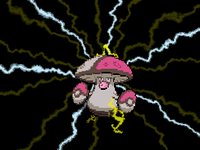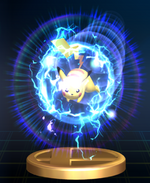Volt Tackle: Difference between revisions
No edit summary |
No edit summary |
||
| Line 18: | Line 18: | ||
[[File:Volt Tackle IV.png|thumb|Raichu using Volt Tackle in Generation IV]] | [[File:Volt Tackle IV.png|thumb|Raichu using Volt Tackle in Generation IV]] | ||
[[File:Volt Tackle.png|thumb|Volt Tackle in Generation V]] | [[File:Volt Tackle.png|thumb|Volt Tackle in Generation V]] | ||
Starting with ''Pokémon Emerald Version'', when a female [[Pikachu]] or Raichu is holding a Light Ball in the {{uv|Pokémon}} games, all of its offspring [[Pichu]] will instinctively know Volt Tackle; trading it is the only way to use it in earlier Generation III games. This is the only way the move can be "learned"; this makes it a kind of signature move for the Pikachu evolutionary line. Volt Tackle is a physical Electric-type move since Generation IV that is as strong as | Starting with ''Pokémon Emerald Version'', when a female [[Pikachu]] or Raichu is holding a Light Ball in the {{uv|Pokémon}} games, all of its offspring [[Pichu]] will instinctively know Volt Tackle; trading it is the only way to use it in earlier Generation III games. This is the only way the move can be "learned"; this makes it a kind of signature move for the Pikachu evolutionary line. Volt Tackle is a physical Electric-type move since Generation IV that is as strong as {{b|Thunder|Pokémon}} (both have 120 power, although Thunder was nerfed in Generation VI to have only 110 power) and is far more accurate (100% compared to Thunder's 70%) and has 15 PP; however, the user receives one-third of the damage inflicted as recoil damage, and it has a lower chance of paralysis (10% compared to 30%). | ||
This move in ''Pokémon'' is a direct reference to Voltteccer, the signature move of the titular character of a Genesis/Mega Drive game called ''Pulseman'' made by Game Freak (the same developer that made ''Pokémon''). The move's look and controls in ''Brawl'' are also direct references to the move's look and controls from ''Pulseman''. | This move in ''Pokémon'' is a direct reference to Voltteccer, the signature move of the titular character of a Genesis/Mega Drive game called ''Pulseman'' made by Game Freak (the same developer that made ''Pokémon''). The move's look and controls in ''Brawl'' are also direct references to the move's look and controls from ''Pulseman''. | ||
| Line 40: | Line 40: | ||
== External links == | == External links == | ||
* [http://www.smashbros.com/wii/en_us/info/info01.html] The Volt Tackle can be seen near the end of the clip. | *[http://www.smashbros.com/wii/en_us/info/info01.html] The Volt Tackle can be seen near the end of the clip. | ||
{{Special Moves|char=Pikachu}} | {{Special Moves|char=Pikachu}} | ||
Revision as of 14:15, July 18, 2014
Template:Infobox Final Smash Volt Tackle (ボルテッカー Borutekkā, Volteccer) is Pikachu's Final Smash in Super Smash Bros. Brawl and Super Smash Bros. 4. When Pikachu uses this attack, it temporarily turns into a gigantic ball of electricity. Pikachu will then fly around the stage at great speeds, and the direction Pikachu goes during this move can be controlled by the player. When an opponent is hit, they take about 11% damage and minor knockback, depending on how much of the attack hits the opponent and how fast Pikachu is moving. The move can deliver significant knockback when the attack button is pressed, creating a large discharge. The Final Smash lasts around 10 seconds, and is generally accepted as extremely powerful by fans, though the difficulty of controlling it and its short length are major drawbacks.
The move has relatively unusual controls. The player cannot control Pikachu's movements directly, they instead control a sort of pivot point; Pikachu gravitates towards this point with elastic physics. The pivot point cannot pass through solid terrain, but Pikachu can. The move's elasticity is reduced in its final moments, which is why Pikachu then moves slower and cannot move through walls. In SSB4, a graphical effect is added to illustrate the pivot point's current location; while this doesn't naturally make the move easier to control, it helps the player visualize what exactly they are doing.
Origin
Starting with Pokémon Emerald Version, when a female Pikachu or Raichu is holding a Light Ball in the Pokémon games, all of its offspring Pichu will instinctively know Volt Tackle; trading it is the only way to use it in earlier Generation III games. This is the only way the move can be "learned"; this makes it a kind of signature move for the Pikachu evolutionary line. Volt Tackle is a physical Electric-type move since Generation IV that is as strong as Thunder (both have 120 power, although Thunder was nerfed in Generation VI to have only 110 power) and is far more accurate (100% compared to Thunder's 70%) and has 15 PP; however, the user receives one-third of the damage inflicted as recoil damage, and it has a lower chance of paralysis (10% compared to 30%).
This move in Pokémon is a direct reference to Voltteccer, the signature move of the titular character of a Genesis/Mega Drive game called Pulseman made by Game Freak (the same developer that made Pokémon). The move's look and controls in Brawl are also direct references to the move's look and controls from Pulseman.
Description from the Instruction Booklet
Generate high-current electricity and use the Control Stick to zoom around the stage. Press the A Button to launch more sparks. Controlling this move requires patience.
Trophy
Pikachu, transformed into a ball of light that can slam into foes. It can also fly to chase down those who try to jump out of range. Sparks get stronger when you press the attack button. However, its increased inertia makes midair movement tough. If you get carried away flying, the effect will end, and you'll destroy yourself. Be careful it doesn't happen to you.
Trivia
- The game will lag if the pause camera is zoomed into an active Volt Tackle, especially during the spark.
- This Final Smash is the only one in Brawl from the Pokémon universe that has the name of an actual move from the series.
See also
External links
- [1] The Volt Tackle can be seen near the end of the clip.



